#my heart goes out to the cast and crew losing their jobs obviously I’m not the victim here but
Explore tagged Tumblr posts
Text
Swept away just announced they are closing next week but they sold me a whole ass ticket for the end of December 😭🥲🥲🥲
#my heart goes out to the cast and crew losing their jobs obviously I’m not the victim here but#that’s crazy. I’ve never had this happen before
20 notes
·
View notes
Text
Amira’s Vanished Hustle, Perceptions of Missed Opportunities, and What Everyone Should Consider About the Story So Far
[deep dive under the cut]
Some messages I got over the weekend were along the lines of: “No Damira again on Friday whew you must be heartbroken huh?” But, y’all, I wasn’t surprised. And to be completely honest, my reaction on Friday was very different from the ones I saw in the tag. Yeah, I was super happy for the adorable Amira and I was also side-eying the glaring absence of Carlos’s besties at his own housewarming -- but my main thought after the clip was: “LOL OH SHIT HERE WE GO.” Because in my mind Friday was an ENORMOUS RED FLAG that the only substantial thing left to do in Amira’s story arc is the cute Bon Voyage party to send her off on her dream trip. Even before this big POV shift happened, Druck hadn’t given us any reason to expect much more than that in her remaining plot, and I’ll elaborate on that here.
I don’t wanna jump to the conclusion that Druck can’t possibly stick the landing, because hey, they might! We have no clear idea what will happen between now and the final goodbye party, so maybe good things are coming that will subvert all of our worst imaginings! But I feel like this is a hinge point in the season to do a little reassessing of expectations... and to come clean about one big reason why I’ve mostly spoken superficially about this season up until now.
The very first red flag, for me, was when I realized Druck was planning to basically pretend Amira never had a job. That oversight might not seem like a big deal to most, and it’s not like her job was the first thing Druck ever made disappear unceremoniously (remember when Leonie and Sara had other close girl friends? lol) but to me it was a signal that my expectations for Amira’s story (based on her previous strong characterization) had maybe been too high. And I immediately felt a bit cheated.
Amira was already so fleshed out coming into her season. She was demanding, quick-witted, and nurturing. She was fiercely protective of her friends, and even more fiercely ambitious, with a willingness to work harder than anyone to get ahead in life. She was sunny but tough-shelled, with a well-established resistance to trusting any men. And, loving her as much as I do, I felt strongly that she deserved to have plenty of brand new story elements that reflected all those things. To have her own story shaped around her, rather than she herself being reshaped to fit Sana’s story.
But then it was finally her turn to shine, in a Summer season, when it would make perfect sense for her to be on a job grind to earn cash for her trip, and... she’s not working? Huh? She managed to work all through a tough school year, but not her free summer vacation? Why? Because of Druck’s low budget? Because they lacked cohesion in the writing process? Some combination of the two? Yikes. Who knows. But suddenly, nonsensically, they had flushed away the perfect framing to showcase her work ethic, her daily perseverance, and her varied interactions (good and bad) with lots of strange customers around Berlin.
It felt like a bad omen to me somehow. Which wasn’t a great mindset to start the season with. And that was the beginning of me trying very, very hard not to be confused and salty about every little thing I began to perceive as missed opportunities to give Amira a new kind of substance in her story.
For example: While David, Matteo, and Sam began having fun off-screen, working on an bold alien movie, Amira inexplicably had no involvement. She kinda scoffed at the idea when it came up on-screen, then immediately lost interest in the conversation because her man was texting. Fair enough, right? That scene was moving her story forward while generously giving a little shoutout to the meta insta storyline, right? The problem is: the off-screen story ended up seeming much more interesting than watching Amira chilling on her own texting a bunch, and we weren’t even given a reason for her to not be part of it after the whole crew was invited to join in. Imagine if we had followed her onto a shitty little makeshift movie set and seen her reacting to the chaos and strangeness of it. Imagine her finding a resourceful solution to a production hiccup or mediating a creative disagreement while trying to hide her own inner turmoil from her friends. And imagine her having an extremely important conversation with David (and/or Matteo and/or Sam) about the film’s deeper themes of alienation and otherness that they can both sadly relate to.
That’s just one weirdly specific scenario, but there are sooo many other ways I fantasized about Amira bonding with her friends (particularly the ones who aren’t cishet white kids or brand new characters). Talking with one or more of them about what it means to be dangerously marginalized, or to be afraid of letting someone get close to you, or to feel torn in two different directions in life. Maybe something like that could still happen before the season ends, but I’m not counting on it. And I think the time has passed for it to have the biggest impact. It could’ve been amazing (and really narratively useful!) if it happened before the resolution of Amira’s brief conflicts with Kiki, Erva, and Mohammed. We saw a lot of scenes with her looking angry and sad, but we weren’t really privy to much of her thought process during all that reflection, so it felt uncomfortably unearned when problems she once saw as insurmountable were shortly waved aside. I would’ve really appreciated even a short conversation with some good change-of-heart exposition.
And while other people were cheering about all the controversial Sana season conflicts being blessedly truncated or completely stripped away, the whole time I couldn’t stop thinking: “Okay, awesome, but what are they gonna replace that storyline with? Nothing?” And, for the most part, that seemed to be true.
But the problem clearly wasn’t limited to a shortage of well-integrated story threads with Amira at their center. It was arguably also a failure to capitalize on the stories they did use. Instead of getting to watch the emotional fight with her mother about punching someone, and witnessing Amira faced with the threat of losing Australia, we only heard about the drama afterward. Just like we only heard about her family’s religious holiday together. Just like we only got a few texts between Amira and Jonas about the refugee event. And just like how, as I sat typing this, Amira’s mother re-blessed the trip off-screen. On and on goes the list of examples of this unfortunate tell-don’t-show approach, and I’m sure a lot of it can be attributed to low budget and tricky cast scheduling, but the time limit excuse probably doesn’t apply if Amira’s main plot really has been efficiently pared down to 7 episodes.
Don’t get me wrong, I want to reserve final judgment on the season until the credits roll, and there are plenty of good things to say about it in the meantime. Yes, it’s been lovely to see so many gorgeous shots of Tua praying, and boxing, and expressing everything from attraction to anguish to helpless rage. Yes, she and Hassan both did some really strong work selling the magnetic pull between their characters, even in the face of (what I consider to be) an underdeveloped narrative that didn’t totally sell me on the relationship overall. Yes, it was wonderful to have some aesthetically pleasing scenes of the girl squad loving and supporting each other, even if they mostly talked about boys the way Amira hoped they wouldn’t. And obviously just having a story about a strong, kind, devoted hijabi girl is vitally important visibility. So I really haven’t wanted to say anything negative in the face of all that...
... but now I have to say: if you’re feeling cheated and mad about the POV shift, then take some time to consider what else specifically you think should’ve happened to Amira before we entered this resolution phase of her story. It seemed like most people were perfectly happy for her to not face any complex conflict, and not have any lingering hardship to dramatically and triumphantly overcome. Every obstacle getting a relatively swift and easy solution felt underbaked to me, but it was a big relief and source of praise for most people in the tags right up until Amira disappeared from clips. So: in hindsight, how would you have added not just length, but also more compelling drama and greater social impact to her story, so that the extra length felt well-used? It’s really worth thinking and talking about that, even if you’re hesitant to voice any criticism of Amira’s part of the story (even after the season ends, and even if it’s totally constructive) -- because thinking and talking about it is how we’ll get that kind of richer, fuller story in the future.
#druck#amira thalia mahmood#representation#storytelling#amira baby i love you and you deserve the world okay#that's been at the core of my issues all season
164 notes
·
View notes
Text
Hey guys. I just rewatched Star Trek: Beyond (my favorite of the reboot Star Trek movies) and given the current discussion about “queer representation” in big budget mainstream movies right now, I wanted to talk about how this movie succeeded where more recent ones have failed miserably.
*Disclaimer, I am not saying Star Trek: Beyond did a perfect job adding queer rep to a mainstream franchise. I’m not even saying it did a good job, it did an ok job and somehow that is still a damn sight better than the crap Disney is trying to pass off as “progress”. This is about the things this movie did that lay a good foundation for queer representation in a franchise, not about how it could have done them better.
Before I start I should say I’m operating on the given that the representation is explicit and obvious. Even the bare bones table scraps Disney tried to claim as “strides” had that element, technically. (Also, obviously, spoilers for Star Trek: Beyond.) Anyway, it boils down to three main points:
1. The rep involved a main character.
2. There was more than one scene.
3. The rep was high stakes/motivation and therefore added major support to the plot. (see below for clarification)
Let’s look at those a little more closely.
1. This is the easiest. The queer representation in Star Trek: Beyond is Sulu, part of the main ensemble cast. A character who is not only part of the main command crew that the story follows, but is high enough ranking on the ship that he has been given command more than once. (Including in this movie.) x

It should really go without saying, but it means that the character isn’t throwaway. This is high stakes for the franchise especially because, as a crucial addendum to this point, Sulu survives the movie. They did not introduce a main queer character only to kill him off.
When the decision was made to add explicit queer representation, they did not half-ass it. The powers that be picked a lead character that was established, aka part of the main crew dating back to the original series, revealed it explicitly, and then made sure the character survived the movie. (So does his husband, btw.)
2. This one is also easy. Sulu’s husband (no, he does not have a name as far as I know, like I said, this is only an ok job) appears multiple times throughout the movie. We see him when the Enterprise arrives at the Yorktown, running during the civilian evacuation at the climactic battle (see point 3), and at the party at the very end that the crew throws for Kirk. x

This goes along with the first point. Not only was the queer representation established in a lead character, his love interest is not addressed in a throwaway scene either. Sulu’s husband, while not made a main focus, is consistently there. Importantly, in places that it makes sense for him to be; welcoming his husband for shore leave and as his plus one in a party.
His presence is normalized. It’s at the expense of over-trivializing his character’s existence, in my opinion, but it’s an important quality none the less. (I should point out that even though I would have liked it to be addressed more explicitly, the relationship being this lowkey fits pretty well into the Star Trek universe so win some and lose some tbh.) And that aspect of the character leads me to my final point.
3. This one is difficult to explain what I mean, but it’s a crucial consideration. The way that this character was placed and the way that the plot is structured in this movie means that Sulu’s husband and daughter are squarely at the center of a classic trope: The Reason We Fight. And, critically, they are the only example in the movie. x

None of the other main characters are implied to have significant others or spouses who are not also members of the crew. Sulu is the token “family man” that ups the stakes for the survival of the cast. Sulu’s family is the familiar face for the audience to answer “why do we care the space station is doomed”, his husband and daughter are shown specifically during the evacuation at the climax for exactly that reason.
And (before it’s been revealed that Sulu has a husband and not a wife) it’s Sulu, his wedding ring, and his daughter’s picture at the con that the camera pans over when Kirk says “personal sacrifices they’ve made” during his voice over at the beginning. Sulu’s family adds the “heart and soul” connection that every movie like this needs, and it’s very explicitly a queer family with no other options to lean on.
What I’m trying to say is this.
Star Trek: Beyond did not add queer rep perfectly. Hell, it was barely adequate. But it was done in a way that made it explicit, not easily cut, and not easily brushed off either. This is not “blink and you miss it” representation. It’s subtle, but it’s also not something that the creators needed to confirm after the fact.
This is a baby step, but it’s one hell of a stride when compared to what Disney is trying to proudly take ownership of. And this is 4 years old. Do better.
#rant#personal#queer things#star trek#star trek beyond#hikaru sulu#no fucking excuses people#i demand better#a riley special
27 notes
·
View notes
Text
Book Seventy-One: Mr. Mercedes
“Life is a crap carnival with shit prizes.”

Well hello, Constant Readers! My copy of Mr. Mercedes has been sitting on my desk for almost a week, waiting for me to review it. This post would have been out sooner, but I discovered Bridgerton on Netflix.

Sorry, not sorry. It was exactly the fluffy, bodice-ripping escapism I needed. For those that don’t know, when I need a palate cleanser from Steve, I escape with a romance novel. Yes, I know these are polar opposite genres, but don’t yuck my yum.
Mr. Mercedes is in a word: brilliant. It’s such a taut, suspenseful story with a diverse cast of memorable characters. It’s another book to recommend for readers that claim not to like Steve. There’s no real horror (other than Brady Hartfield), just good old-fashioned suspense.
The story opens at a job fair where hundreds of people are waiting for their chance at gainful employment. Steve introduces us to several down-on-their-luck characters and we begin to empathize with them. But then, Steve feels the need to be Steve, and a Mercedes comes driving through the crowd of job-seekers, killing eight people; including a mother and her baby. The driver is never caught.
We’re then introduced to retired Detective Bill Hodges; who needs to cut back on the carbs and beer, walk a few miles a day, and stop fantasizing about suicide. Bro, stop putting that gun in your mouth! So. Many. Germs. But one day, Bill gets a letter from The Mercedes Killer, the person claiming responsibility for the City Center job fair murders. The Mercedes Killer tells Bill to meet him online for a chat. For the first time in a while, Bill is interested by something other than his father’s gun.
Bill begins by talking to the family of the woman who owned the Mercedes that had been stolen, and responsible for the crash. Olivia Trelawney was adamant she had locked the doors to her car. But the guilt from the crash eventually led to her suicide. Bill meets up with Olivia’s sister, Janey. Janey tells him more about Olivia’s mental state leading up to her suicide, and how she claimed she was hearing the screams of the murdered people. Bill also teams up with neighborhood kid Jerome, who helps Bill get online and leave messages for the killer.
Meanwhile, Brady Hartfield is working two jobs as a Cyber Patrol (think Geek Squad) rep for Discount Electronix, and ice cream man; and wondering what Bill thinks of the letter he sent him. Brady is smug in the knowledge he committed the perfect crime, and wonders if he can do it again. In addition to patrolling Bill’s neighborhood in his ice cream truck, he’s trying to take care of his alcoholic mother. And by taking care of, I mean that in a sexual way. It’s gross. Trigger warning. We also learn Brady had a younger brother who had a tragic accident that led to serious developmental damage, and when he fell down a flight of stairs, Brady didn’t really do much to help him out. So, he and his mom have this sick, co-dependent relationship based on family secrets.
Brady thinks he’s something of a computer and technology genius (he invented the Roomba first, don’t-cha-know); and has turned his entire basement into his workshop. He and Bill have left each other messages back and forth online, and after one carefully plotted message from Bill, Brady loses his mind. He decides he’s going to poison Jerome’s dog, and Bill will obviously get the message that Brady did it to get back at him. But it’s almost a comedy of errors, and Brady’s mom ends up ingesting the poisoned hamburger meant for the dog, and dies. Now Brady’s really pissed. He’s out for blood.
Despite Bill’s best intentions, his relationship with Janey turns romantic, and Bill has yet another reason to stop putting that gun in his mouth. When Janey and Olivia’s mom dies, Bill meets their cousin Holly Gibney, who goes onto become the star of the whole damn trilogy (and then some). But Brady gets his revenge at the funeral, and blows up Bill’s car, which Janey happens to be driving. Brady’s pissed he killed Janey, and not Bill. But he can’t focus on that too long, he has much bigger plans.
Brady decides he’s going to take himself to the ‘Round Here concert and blow himself up wearing a vest full of ball bearings. So, he disguises himself as a wheelchair bound kid (think Norman from Rose Madder) and makes his way into the show.
Meanwhile, Bill, Jerome and Holly are able to determine The Mercedes Killer’s true identity (thanks in part to the crazy old lady across the street, telling Bill the ice cream truck had been driving around too much); and they’re able to get to the concert just in time to prevent Brady from killing an entire arena full of people. Bill has a heart attack in the process, but he’s fine. Like I said: better diet and more exercise.
The book ends with Brady at a brain injury clinic... not dead...
DUN-DUN-DUN!!!!
Seriously, it’s such a well written, suspenseful ride. If you haven’t read this trilogy, you need to. I promise you won’t regret it.
Total Wisconsin Mentions: 42
Total Dark Tower References: 66
Book Grade: A+
Rebecca’s Definitive Ranking of Stephen King Books
Doctor Sleep: A+
The Talisman: A+
Wizard and Glass: A+
11/22/63: A+
Mr. Mercedes: A+
Under the Dome: A+
Needful Things: A+
On Writing: A+
The Green Mile: A+
Hearts in Atlantis: A+
Full Dark, No Stars: A+
Just After Sunset: A+
Rose Madder: A+
Misery: A+
Different Seasons: A+
It: A+
Four Past Midnight: A+
Stephen King Goes to the Movies: A+
The Shining: A-
The Stand: A-
Bag of Bones: A-
Duma Key: A-
Black House: A-
The Wastelands: A-
The Drawing of the Three: A-
The Dark Tower: A-
Dolores Claiborne: A-
Blaze: B+
Hard Listening: B+
Revival: B+
Nightmares in the Sky: B+
The Dark Half: B+
Joyland: B+
Skeleton Crew: B+
The Dead Zone: B+
Nightmares & Dreamscapes: B+
Wolves of the Calla: B+
‘Salem’s Lot: B+
Song of Susannah: B+
Carrie: B+
Creepshow: B+
From a Buick 8: B
The Girl Who Loved Tom Gordon: B
The Colorado Kid: B-
Storm of the Century: B-
Everything’s Eventual: B-
Cycle of the Werewolf: B-
The Wind Through the Keyhole: B-
Danse Macabre: B-
The Running Man: C+
Cell: C+
Thinner: C+
Dark Visions: C+
The Eyes of the Dragon: C+
The Long Walk: C+
The Gunslinger: C+
Pet Sematary: C+
Firestarter: C+
Rage: C
Desperation: C-
Insomnia: C-
Cujo: C-
Nightshift: C-
Faithful: D
Gerald’s Game: D
Roadwork: D
Lisey’s Story: D
Christine: D
Dreamcatcher: D
The Regulators: D
The Tommyknockers D
Next up is The Bazaar of Bad Dreams, which is a collection of short stories I’m reading for the second time. We all know my thoughts on short stories, but this collection is pretty solid.
I had a real bittersweet moment today: I received a delivery with the last three Stephen King books I need to read to complete this challenge. The end is in sight, Constant Readers!
Until next time, Long Days & Pleasant Nights, Rebecca
1 note
·
View note
Text
Fall Anime 2017 Part 4: Screenshots don’t lie
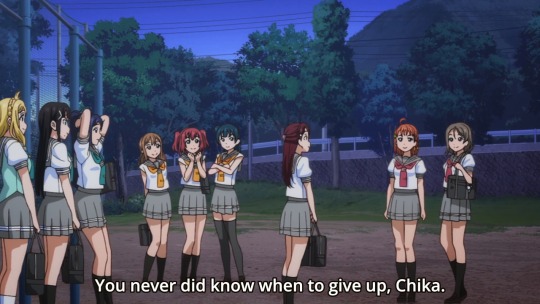
Saturday’s a very busy day this season, and all the sequels are hitting too. Time to get to work!
Previously:
• Part 1: Maximum Something
• Part 2: The snooze cruise
• Part 3: Fooled again
Burendo Esu (Cat Balls the Animation)
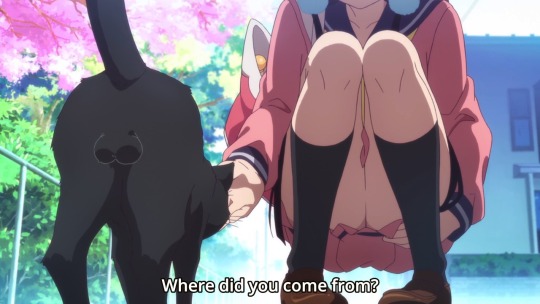
Blend S is the story of schoolgirl Maika that has “mean eyes” (basically, she has tsurime in a tareme world), which prevents her from getting a job other than the one in a moe gimmick-themed café, where her duty is to make “mean eyes” at the customers. The other waitresses play a tsundere, an imouto, an idol and an onee-san. So yeah, that’s one way to get your standard moe show cast together. But wait! The twist here is that Maika is not actually mean! Quite the opposite actually! And that goes for all the other waitresses too! While girls getting forced into moe archetypes is a pretty amusing/scary concept, this is of course a Kirara manga, so they’re just different moe archetypes underneath. In short, the concept doesn’t amount to much. As far as Kiraralikes go, this isn’t a bad one though. It’s colorful, cute and a little funny, and splits the difference between a pure moefest like Knohana Kitan and the more structured comedy of a Working (obviously). Only the pervy Italian manager and his obsession with his blob underlings gets old pretty fast. If you’re down for a show like this, this is probably the one to watch, because unlike Konohana Kitan I didn’t wish for it to end.
Code: Realize - Sousei no Himegimi
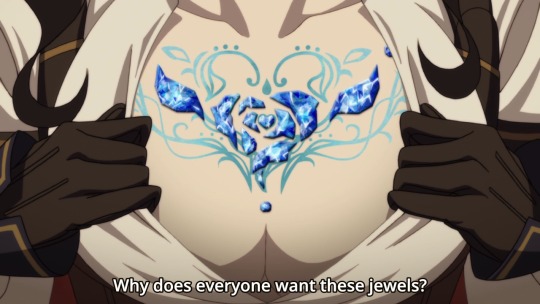
While we’re on the topic of “best of the breed”, Code: Realize is an upmarket otome harem. I know, right. The setting is a basic steampunk universe, the bishounens are Arsène Lupin, Victor Frankenstein &c, and our bland heroine’s super special trait turns out to be killing everything she touches due to some jewels in “her heart”. I mean, who hasn’t been there. So everyone wants to “steal her heart” and Code: Realize is very keen to point out the double meaning of this constantly. Hey, we kinda did it in Katawa Shoujo so I can’t really complain. The thing is that Code: Realize is very obvious, but it’s also not all that bad – the fact that is has more going on than nothing at all already makes it the best otome harem since Akatsuki no Yona: It looks fairly pleasant, none of the main characters are tremendous assholes, and there seems to be some sort of story to go with the pretty boys. But it’s also not as hammy and ostentatious as, for example, Dance with Devils, so it’s caught in a middle ground where I can appreciate it not sucking tremendously, but I also don’t feel like watching it – because it’s too respectable.
Dynamic Chord
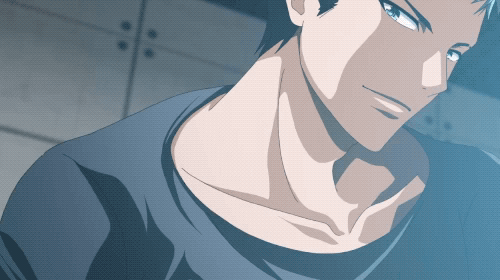
Dynamic Chord is another otome VN, this time about rock bands. Since this is 2017, apparently the production committee thought they could cut out the middleman, leave out the bland girl and just make a boyband anime instead, because those are all the rage right now. So it’s Tsukipro, apart from the bit where Tsukipro looks like a Ghibli movie next to this. Dynamic Chord is a production catastrophe that looks closer to a no-budget gag short of the Pikotarou Lullaby type (note: I mean “catastrophe” in the absolute sense, for all I know this could all be calculated perfectly and the producers are laughing all the way to the bank). The show consists almost entirely of two things: Long, quiet zooms and pans over stills, and montages, mostly of “performances”. Those performance themselves are really something else too. What if I told you that this is a show in 2017 that does not seem to feature ANY 3DCG? Turns out 3DCG actually costs money too, so when the band plays, they do paperdoll tweens of 2D artwork. Oh, and outside the performances lack of CG means you get the worst animated car since the QUALITYVAN. There’s also just baffling stuff like walk loops that don’t loop. Given that these montages are all endlessly long, you might think there’s not much space for a story. And you’d be right. Basically nothing happens, the singer of a band gets a bad case of the broods so some guy from another band has to substitute for him. That’s it. Would have easily fit into 3 minutes, but I have to say that by the end of this show’s 24 minutes, I was straight up laughing my ass off when the next montage of bad stills started right after the last one ended. That’s something, right?
Garo - Vanishing Line
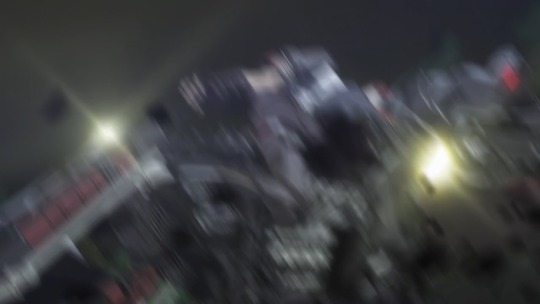
I’ve seen Garo before, but last time I didn’t know it was a tokusatsu meta-franchise, the anime versions of which really only share that there’s a gothick looking motherfucker fighting horrors called Horrors. So this has little to do with the last ones: different crew, different studio, different setting. Because this version of Garo is most definitely set IN AMERICA: The main character is a gothick looking motherfucker called "Sword” that charitably resembles Hellboy, and less charitably resembles a Leifeld original. He rides a big hawg around a Big Apple, eats big bloody steaks and looks at big boobies a lot because you know, setting. It’s charming in its idiocy, and this is MAPPA so you get a lot of fights with very nice animation too. I could watch this simply for the action, but I won’t because there’s a Murrica-sized caveat here: The fights take place at night, are edited very rapidly and most importantly their idea of an impact frame is to do an extreme camera shake effect with intense motion blur. And there is a lot of impact frames – believe me, that might have been the easiest screenshot to find for an article yet, and I highly suspect I could have found worse ones if this wouldn’t bring the point across already. I simply can’t tell what the fuck is going on because everything is an incomprehensible mess, no matter how nice the frames beneath the effects are. It’s pretty infuriating because this show is one mouse click away from being a good time, simply disable your After Effects layer with the shake on it. But I can’t do that for them, so Vanishing Line ends up being a bad time instead. And even if you are interested in some big, zany action in the ol’ Gotham, there’s a little something that makes Vanishing Line instantly obsolete:
Kekkai Sensen (Blood Blockade Battlefront) & Beyond
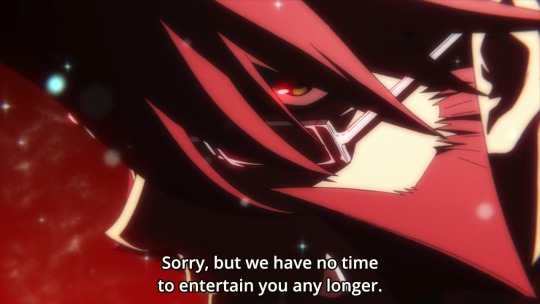
Yeah boiiiiiiii, Kekkai Sensen is back. I had forgotten how fun this show can be, and we’ll discuss the reasons shortly. A lot has happened since 2015, and I have a good reference point for it now: Kekkai Sensen is basically One-Punch Man without The Joke. It’s an universe full of all sorts of crazy nonsense and a bunch of cool dudes that try to keep thing under control, usually in an explosive manner. The one really important thing that Beyond changes is that it’s not directed by Rie Matsumoto. Shigehito Takayanagi is taking over, and while that guy is a noted jobber of little distinction (previous credits: TWGOK, Dagashi Kashi and uh... Toyko ESP...), he’s at least enough of a craftsman to imitate Matsumoto’s style very well. I only found out about this after the fact, and wouldn’t have noticed the difference otherwise. It is noticeable if you look for it though: this episode has all of the stylish action antics, but none of the more moody content that Matsumoto’s original character (do not steal) White brought to the show. I liked most of White’s scenes with Leo and they gave season 1 some welcome emotional grounding, but to be quite honest, it’s not what I watched Kekkai Sensen for. I can definitely accept losing it if this time the show isn’t consumed by White’s subplot and doesn’t culminate in an ending that not only is all about her, but also comes out a season after everyone stopped caring because auteurs can’t manage a production. With Kyousougiga and Kekkai Sensen S1, Matsumoto has shown a 100% track record of donking her endings, so I’m not complaining she got replaced with someone who just gets the job done. Especially if it’s still Bones relying on Yutapon for action cuts; when shit hits the fan, it looks straight up incredible and makes me question why I slummed it with My Hero Academia for three seasons when I can get the same amount of awesome fights in a single episode of this. And hey, White is still in the ending, so maybe we will get the less crazy end of it covered as well. Just keep the priorities straight this time around, please.
Houseki no Kuni (Land of the Lustrous)
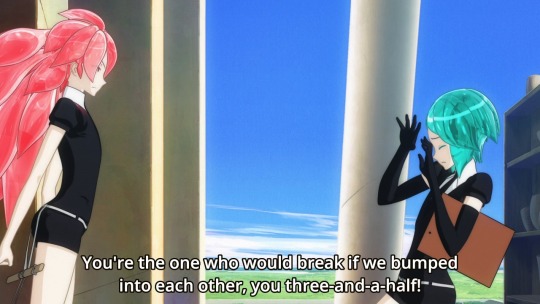
Houseki no Kuni is a manga about gijinka gems of indeterminate gender that takes the amusing step of Mohs hardness directly translating into Shounen Powerlevel™. Apart from that, there’s not much content in this episode 1: We get to know the characters and a glimpse and how a society of a bunch of brittle gems in makeup works. What makes this interesting is that the setting is intriguingly vague and very pretty (think: Haibane Renmei), and the characters seem to be fairly strong and likeable. Not exciting, but I could see myself watching this just for the atmosphere. The big downside of it is that it’s a 3DCG show, and not one of those fancy mocapped ones either. The animation is, in a word, bad: robotic and clumsy, as usual. I’ll readily admit that in screencaps it looks great, especially the crystal shaders that would be difficult to pull off in 2D animation. Houseki no Kuni seems very okay, but it has a hard time on this crowded Saturday so I don’t think I’ll bother with it right now. If it delivers in the long run, I’ll readily admit it to my backlog though.
Love Live! Sunshine!! S2!!!
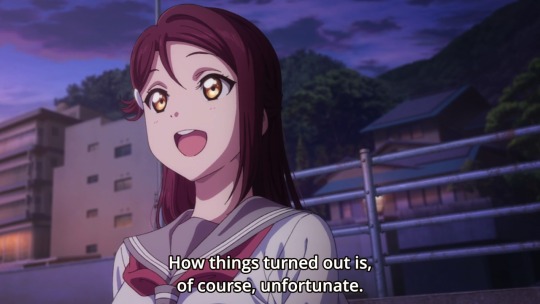
Sunshine’s back as well, and finds itself in an awkward spot right away. This first episode has a lot of things to get out of the way: Tying up the last season properly because the final episode of S1 fumbled that, reminding the audience of the characters, and setting up a new drama arc. In practice, that means it ends up feeling a lot more like the lost E1S13 than the S2E1 it is, because the other two aspects are pretty pointless: Reintroducing the characters just means they all shoot off their catchphrase in turn, and the brand new conflict is (hold on to your seats for this one) that the school is getting closed and there’s a new Love Live. With all these things going on and none of them being all that interesting, the episode feels very rushed and just accomplishes establishing that yes, it’s a Love Live show. I guess that is exactly what it was meant to do and I can say that at least they have it out of the way now. Well, the last time I said Sunshine had gotten something out of the way, it was the obsession with µ’s in episode 1, the getting out of the way of which ended up lasting 10 episodes. It’s gone now (thankfully), but maybe I shouldn’t assume too much here. So yeah, fairly weak first episode, but it’s not like I wasn’t going to watch this to the end and even at its most rushed and pointless it’s still Love Live: a polished Five Guys hamburger of a show that doesn’t exactly need to be great to be a joy to watch.
Two Car
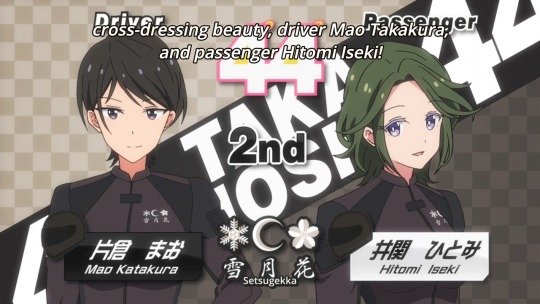
I expected Two Car to be That Show: the one where a schoolgirl discovers her sudden love for Thing and goes on to experience Thing with the help of her friends. Two Car isn’t in the K-ON/Bakuon/etc mould however, it’s much more similar to the sports show style of Girls und Panzer, wacky sport with themed teams of contenders in a world where everyone seems to care about it a little too much. It helps that real sidecar racing is already weird as hell (looking forward to the breathless Anime Now article about how it’s a thing that actually exists) and is less motorcycle racing and more Twister on a fast-moving platform. Quite coincidentally, Two Car is also tremendously gay, as you’d expect from a show about two-girl teams in very tight leather crawling over each other competitively. The main girls aren’t even so blatant (and shown to have a crush on their male instructor, who has taken off to the aptly named Isle of Man), but the opponents are all some sort of standard yuri pairing. So yeah, the setting is a goofy blast, but I’m sad to report that episode 1 has tremendous structural problems. All the team introductions are very clumsy and intercut with an equally clumsy introduction of the setting, the sport and the main girl’s extensive backstory. I will give this more chances because the setup has a lot of potential, but I really hope this shapes up on the storytelling front or I won’t make it very far in.
#Love Live! Sunshine!!#Blend S#Code Realize#Dynamic Chord#Vanishing Line#garo#Kekkai Sensen#Houseki no Kuni#Two Car#blood blockade battlefront#anime#impressions#fall2017
2 notes
·
View notes